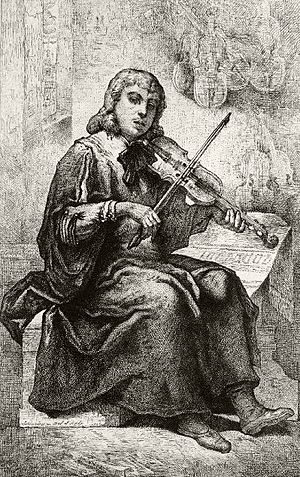Nicola Amati facts for kids
Quick facts for kids
Nicola Amati
|
|
|---|---|
 |
|
| Born | 3 December 1596 |
| Died | 12 April 1684 (aged 87) Cremona, Italy
|
| Resting place | Cremona Cathedral |
| Nationality | Italian |
| Education |
|
| Known for | Luthier |
|
Notable work
|
|
| Style |
|
| Movement | Cremonese school |
| Spouse(s) |
Lucrezia Pagliari
(m. 1645; died 1684) |
Nicola Amati (born December 3, 1596 – died April 12, 1684) was a famous Italian instrument maker. He was known for creating beautiful string instruments like violins. Nicola came from Cremona, Italy, a city famous for its instrument makers.
He was part of the Amati family, a very important family of luthiers. A luthier is someone who builds or repairs string instruments. Nicola Amati taught many other famous instrument makers. These included Andrea Guarneri and Giovanni Battista Rogeri. Some people also believe he might have taught Antonio Stradivari.
Contents
About Nicola Amati's Life
His Early Years
Nicola Amati was the fifth son of Girolamo Amati. His grandfather was Andrea Amati. Both his father and grandfather were also famous instrument makers. Nicola was one of 12 children in his family. His mother was Laura de Lazzarini.
Learning His Craft
Nicola likely learned how to make instruments from his father and uncle. By the 1620s, Nicola was the main instrument maker in the Amati workshop. He took over the family business.
The Italian Plague
A terrible sickness, the Italian plague, hit Italy from 1629 to 1631. It affected Cremona, where the Amatis lived. In 1630, the plague sadly killed Nicola's father, mother, and two of his sisters. After losing his parents, he lived with his sister.
Family Life
Nicola Amati married Lucrezia Pagliari on May 23, 1645. His student, Andrea Guarneri, was at the wedding. Nicola and Lucrezia had four sons and four daughters. Their son, Girolamo Amati II, also became an instrument maker. He was the last luthier in the Amati family.
His Passing
Nicola Amati died on April 12, 1684. He was 87 years old. He passed away in his hometown of Cremona, Italy.
Nicola Amati's Instruments

The Amati Style of Instruments
Nicola Amati's instruments are often thought to be the best for modern playing. When he was young, his instruments looked a lot like his father's. They were smaller and had a high arch in the middle.
The Amati family often used Latin names on their instrument labels. For example, Nicolaus was the Latin form of Nicola.
The "Grand Amati Pattern"
Around 1630, Nicola started to make his own unique instruments. By 1640, he developed what is now called the "Grand Amati Pattern." These instruments were a bit larger. They were about 35.6 cm (14 inches) long. They were also wider, about 20.9 cm (8.25 inches) across. This larger size helped them produce a bigger, richer sound.
His instruments were known for their elegant look. They had beautiful curves and clean, decorative borders. They also had a clear, amber-colored varnish. The "Grand Amati Pattern" inspired other famous makers in Cremona. These included Vincenzo Rugeri and early works by Antonio Stradivari.
Nicola Amati's Famous Students
After the Italian plague, Nicola Amati was one of the few great instrument makers left. The demand for musical instruments grew in the 1640s. This meant he needed help. He was one of the first to take students who were not part of his family.
- Andrea Guarneri: Andrea Guarneri was one of Amati's most famous students. He later started his own family of violin makers, the Guarneri Family.
- Francesco Rugeri: Francesco Rugeri might have been a student of Nicola Amati. We don't have clear records of him living in Amati's house. However, Francesco sometimes put labels in his instruments saying he was Amati's student. Nicola Amati was also the godfather to Francesco's son. This shows they had a close connection.
- Antonio Stradivari: It's a big question whether Antonio Stradivari was a direct student of Nicola Amati. One label from Stradivari in 1666 says "Alumnus Nicolais Amati," meaning "student of Nicolò Amati." However, some experts think Stradivari's early instruments look more like Francesco Rugeri's work. Also, Amati and his known students used a small pin or hole in their instruments. Stradivari did not use this. This suggests Stradivari might have learned his skills from someone else, like Francesco Rugeri, even if they were all influenced by Amati.
Other known students of Amati include:
- Giovanni Battista Rogeri
- Matthias Klotz
- Jacob Railich
- Bartolomeo Pasta
- Bartolomeo Cristofori
- Giacomo Gennaro
- Giacomo 'Tedesco'
- Giacomo Reilich
- Giovanni Segher
- And his son, Hieronymus II (Girolamo II).
Later Years
By the late 1670s, Nicola Amati was less involved in making instruments. His son, Hieronymus II, took over more of the work. Nicola Amati passed away in 1684.
Where to See Amati Instruments
Nicola Amati's instruments are very rare today. Many of them are displayed in museums around the world. You can find his work at places like:
- The Metropolitan Museum of Art in New York
- The Museo del Violino in Cremona, Italy
- The Royal Academy of Music Museum in London
Some musicians are lucky enough to play these historic instruments. Thomas Bowes plays a Nicola Amati violin. Chi-chi Nwanoku plays an Amati double-bass.
Images for kids
See also
 In Spanish: Nicolò Amati para niños
In Spanish: Nicolò Amati para niños


